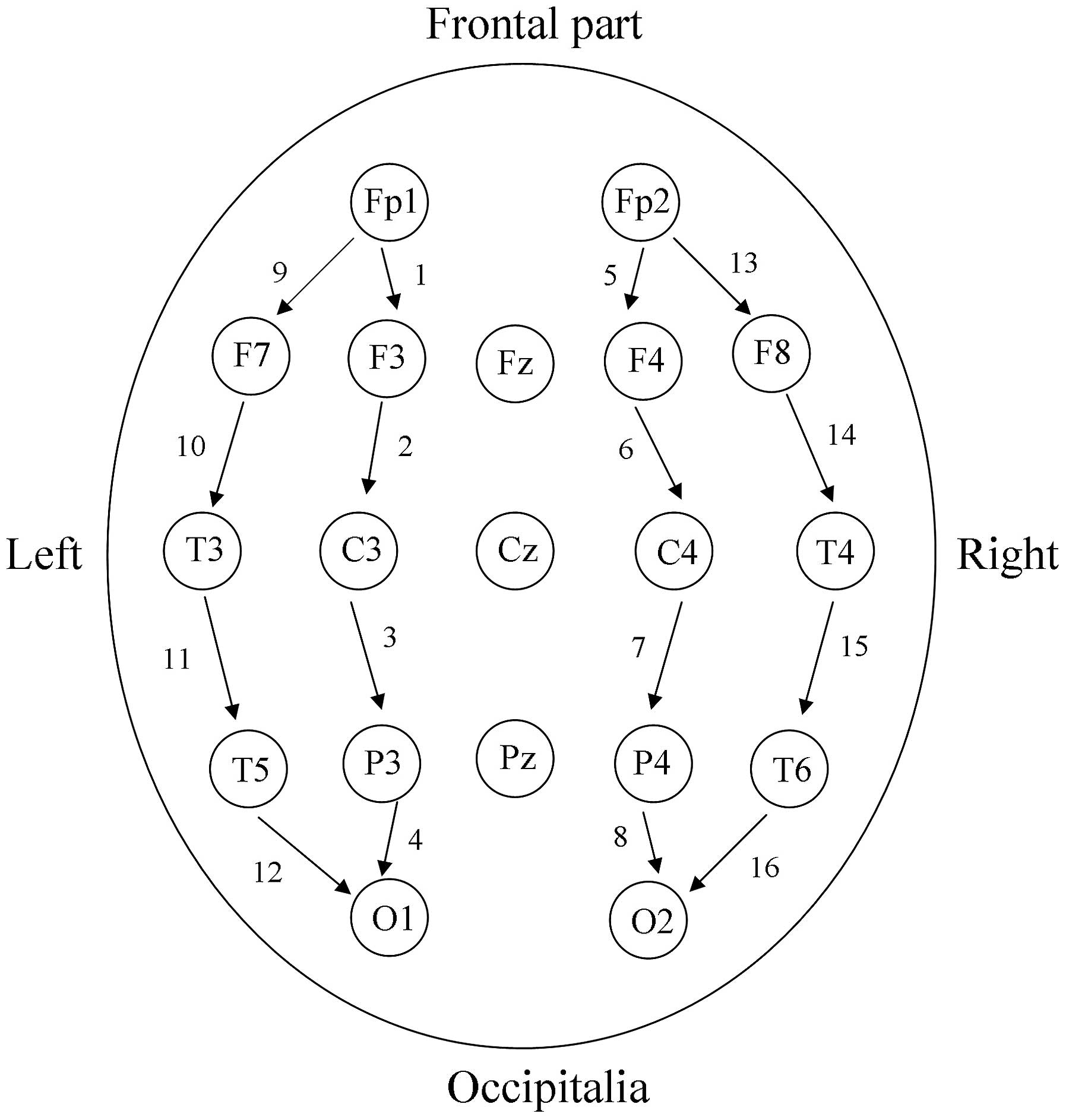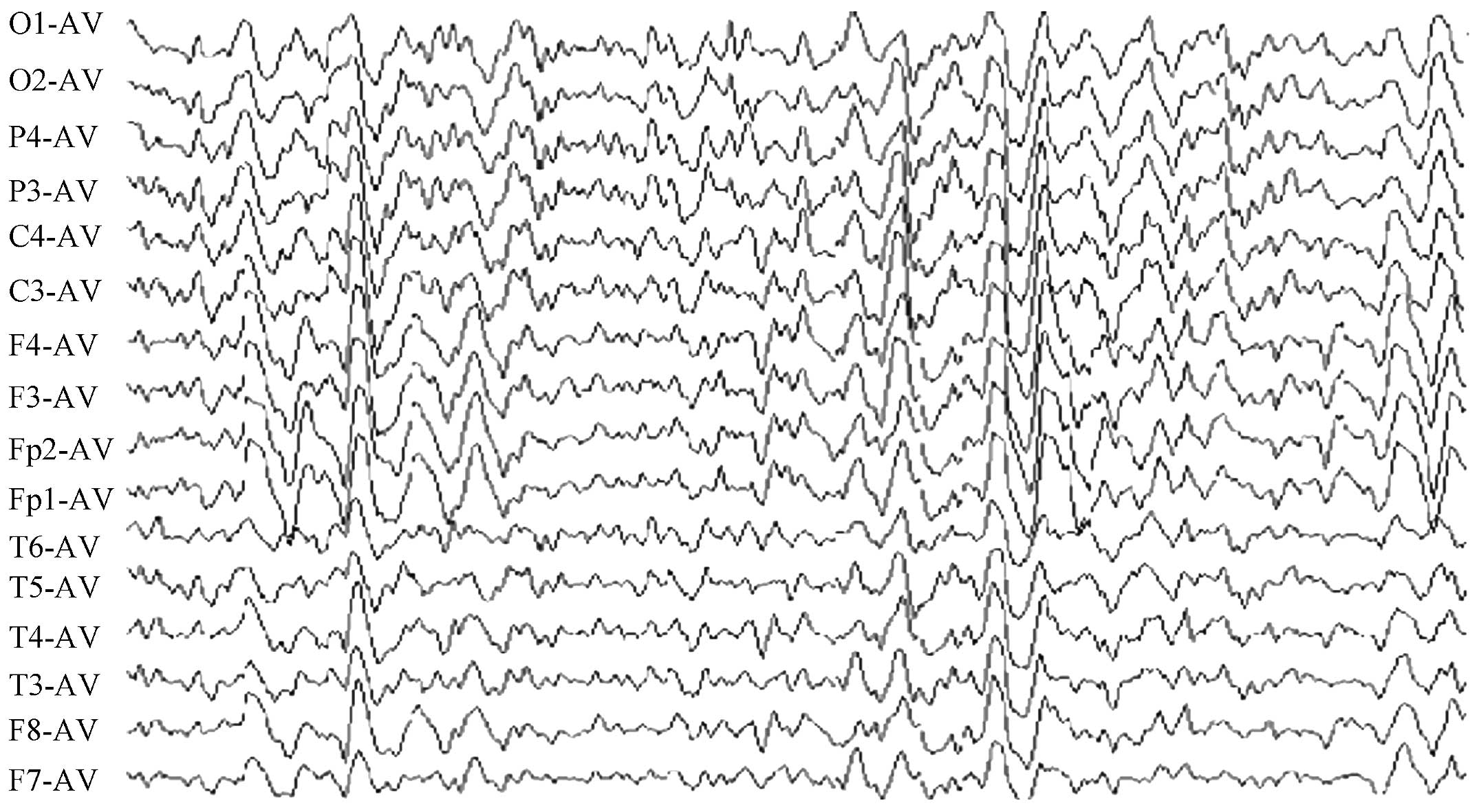Introduction
Previous studies have indicated that there is a
relationship between ovarian hormones and central nervous system
function. An overall increase in brain activation with enhanced
estradiol levels is observed during the menstrual cycle (1,2).
Progesterone, which is synthesized in the ovary, is the most
important progestin in humans and has cerebral depressant and
hypnotic effects (3). The spectral
analysis of the electroencephalogram (EEG) may provide specific
information with regard to the status of the brain. For example,
the slow wave may reflect the homeostatic processes of sleep
(4). δ (0.5–4 Hz) EEG power is
highest at the start of the night when the need for recuperation is
greatest and decreases during the night as this requirement is met.
However, the current case report presents a female patient whose
EEG recording demonstrated a rare generalized 3 Hz δ frequency band
in the daytime during waking status. To the best of our knowledge,
this study is the first report prolonged menstruation with an
abnormal δ EEG power.
Case report
A healthy 51-year-old female with no history of head
trauma, coffee or alcohol consumption and contraceptive drug use
was admitted to the Department of Urology (Second Xiangya Hospital,
Central South University, Changsha, China). The patient had not
previously experienced postpartum headaches, but had suffered from
heart palpitations and dizziness for 6 months and was receiving
treatment in the Department of Neurology. The study was approved by
the ethics committee of Central South University, Changsha, China.
Written informed consent was obtained from the patient.
The patient had experienced prolonged menstruation
and increased menstrual blood volume for 6 years. Due to dizziness
and palpitations, the patient was admitted to the Department of
Urology and further evaluations were performed. General physical
and neurological examination results were normal. The routine
laboratory tests showed mild anemia of the patient. Gynecological
examination revealed secondary anemia and hysteromyoma. Upon
admission, hemoglobin levels were low at 69 g/l; however, levels
increased to 115 g/l following blood transfusion and resection of
the hysteromyoma. EEG activity was continuously recorded at rest
with 32 electrodes using the standard EEG electrode placement
(Fig. 1). The EEG examination
results indicated a generalized 3 Hz δ frequency band with 30–80 μV
power and a long-range δ frequency band during hyperventilation
(Fig. 2). Computed tomography and
magnetic resonance imaging scans of the head of the patient showed
no significant abnormalities. There was no significant improvement
in the EEG recordings one month following the first EEG
examination.
Discussion
The current case report presents a female with
prolonged menstruation and increased menstrual blood volume whose
EEG recording demonstrated a rare generalized 3 Hz δ frequency band
in the waking state. A previous epidemiological study of
generalized δ frequency showed that a 3 Hz δ frequency band mainly
occurs following brain injury, such as encephalitis or mental
confusion, and during the sleeping state (5). Although a small number of individuals
exhibit a slightly abnormal δ frequency in EEG, the observations in
the present case report are extremely rare. Furthermore, the
patient demonstrated a unique and generalized δ frequency with no
cerebral injury or brain disease. This indicated an obvious
abnormality of cerebral activity.
EEG δ frequency is enhanced during non-rapid eye
movement sleep following sleep deprivation and therefore, EEG δ
frequency is used as a parameter to model process S (homeostatic)
in the two-process model of sleep (6). Previously, several studies have
indicated that EEG δ frequency is regulated independently of sleep
duration (7,8). For example, high amplitude EEG δ
frequency occurs during the waking state following systemic
atropine administration or hyperventilation in children (9,10).
Several sleep regulatory substances may enhance the EEG δ
frequency, such as tumor necrosis factor-α, growth hormone
releasing hormone and interleukin-1, all of which may induce a
change in the duration of sleep (11).
In the present case report, generalized δ frequency
was found to correlate with estrogen levels in a patient with
prolonged menstruation. According to previous studies, a general
increase in brain activation may be associated with enhanced
estradiol levels, such as EEG powers (12). However, to the best of our
knowledge, this case study was the first to demonstrate enhanced δ
frequency levels under the specific conditions of the patient.
Therefore, we hypothesize that the prolonged menstruation and
increased menstrual blood volume may have enhanced estrogen levels
and triggered the generalized δ frequency.
In conclusion, the present report evaluates an
unusual case involving a female patient who had prolonged
menstruation and an abnormal δ EEG power. The results illustrated
that the prolonged menstruation and increased menstrual blood
volume may have induced the generalized δ frequency without brain
injury.
Acknowledgements
This study was supported by grants from the Hunan
Provincial Social Science Foundation of China (no. 12YBA323) and
Hunan Provincial Natural Science Foundation of China (no.
10JJ5020); Hunan Provincial Planning Project of Science and
Technology of China (grant no. 2013FJ4224).
References
|
1
|
Li B, Zhang Y, Shi B, Chen Y, Zhang Z and
Liu T: Gardenia oil increases estradiol levels and bone material
density by a mechanism associated with upregulation of COX-2
expression in an ovariectomized rat model. Exp Ther Med. 6:562–566.
2013.PubMed/NCBI
|
|
2
|
Dietrich T, Krings T, Neulen J, Willmes K,
Erberich S, Thron A and Sturm W: Effects of blood estrogen level on
cortical activation patterns during cognitive activation as
measured by functional MRI. Neuroimage. 13:425–432. 2001.
View Article : Google Scholar : PubMed/NCBI
|
|
3
|
Goldfein A: The gonadal hormones and
inhibitors. Basic and Clinical Pharmacology. Katzung BG: 7th ed.
Appleton and Lange; Stamford, CT: pp. 653–683. 1997
|
|
4
|
Campbell IG, Bromberger JT, Buysse DJ,
Hall MH, Hardin KA, Kravitz HM, Matthews KA, Rasor MO, Utts J and
Gold E: Evaluation of the association of menopausal status with
delta and beta EEG activity during sleep. Sleep. 34:1561–1568.
2011.PubMed/NCBI
|
|
5
|
Wang X, Zhang J, Yang Y, Dong W, Wang F,
Wang L and Li X: Progesterone attenuates cerebral edema in neonatal
rats with hypoxic-ischemic brain damage by inhibiting the
expression of matrix metalloproteinase-9 and aquaporin-4. Exp Ther
Med. 6:263–267. 2013.PubMed/NCBI
|
|
6
|
Yeh JR, Peng CK, Lo MT, Yeh CH, Chen SC,
Wang CY, Lee PL and Kang JH: Investigating the interaction between
heart rate variability and sleep EEG using nonlinear algorithms. J
Neurosci Methods. 219:233–239. 2013. View Article : Google Scholar : PubMed/NCBI
|
|
7
|
Borbély AA: A two precess model of sleep
regulation. Hum Neurobiol. 1:195–204. 1982.
|
|
8
|
Davis CJ, Clinton JM, Jewett KA, Zielinski
MR and Krueger JM: Delta wave power: an independent sleep phenotype
or epiphenomenon? J Clin Sleep Med. 7(Suppl): S16–S18.
2011.PubMed/NCBI
|
|
9
|
Bringmann A: Topographic mapping of the
cortical EEG power in the unrestrained rat: peripheral effects of
neuroactive drugs. Arch Ital Biol. 133:1–16. 1995.PubMed/NCBI
|
|
10
|
Li B, Wang L, Liu Y, Chen Y, Zhang Z and
Zhang J: Jujube promotes learning and memory in a rat model by
increasing estrogen levels in the blood and nitric oxide and
acetycholine levels in the brain. Exp Ther Med. 5:1755–1759.
2013.PubMed/NCBI
|
|
11
|
Yasuda T, Yoshida H, Garcia-Garcia F, Kay
D and Krueger JM: Interleukin-1-beta has a role in cerebral
cortical state dependent electrocephalographic slow-wave sctivity.
Sleep. 28:177–184. 2005.
|
|
12
|
Wibowo E, Deurveilher S, Wassersug RJ and
Semba K: Estradiol treatment modulates spontaneous sleep and
recovery after sleep deprivation in castrated male rats. Behav
Brain Res. 226:456–464. 2012. View Article : Google Scholar : PubMed/NCBI
|
















